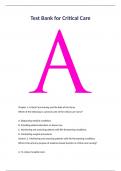Exam (elaborations)
Test Bank for Critical Care Nursing Diagnosis and Management 9th Edition by Linda D. Urden, Kathleen M. Stacy Included All Chapters 1-48
- Course
- Institution
Test Bank for Critical Care Nursing Diagnosis and Management 9th Edition by Linda D. Urden, Kathleen M. Stacy Included All Chapters 1-48
[Show more]



